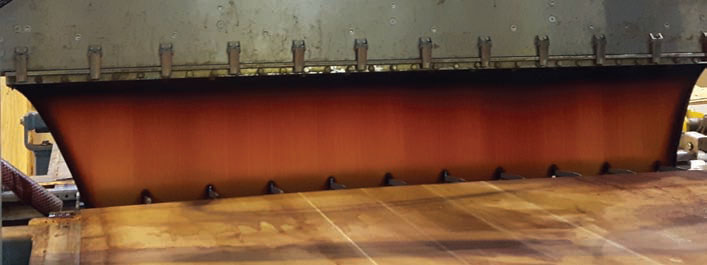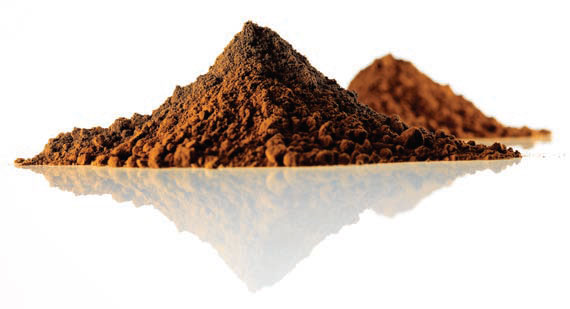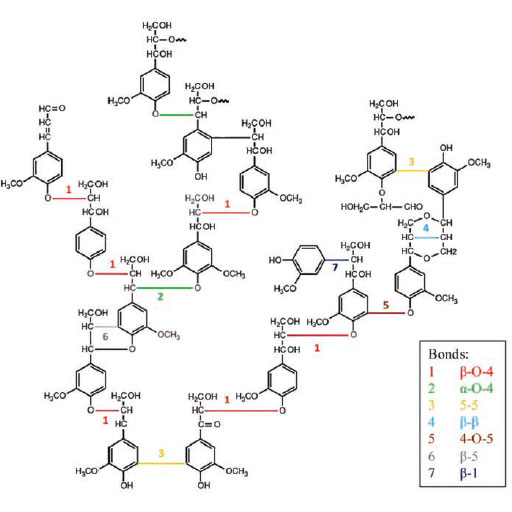Lignin Based Binders Standard at Last
15 March 2017Lignin-based binders have been a long time coming; but now as a substitute for phenolbased resins they are ready to become the industry standard. Charles Markessini of Chimar Hellas and Dr Christian Hubsch, Head of Lignin business at UPM Chemicals, explain how the chemistry and the technology have caught up with the needs of producers; and why the lignin revolution may have arrived
Lignin based binders (LPF) are a subject that can be considered at the same time to be a novelty and a scientifically exhausted subject. The first articles and patents on using lignin as a component of a binder emerged in the seventies and related research started even before that. The actual structure of the lignin molecule is still a subject of great debate, but as soon as the first models surfaced it was evident that it resembles remarkably the structure of a fully-set phenol formaldehyde polymer. It was therefore hypothesized that it should not be difficult to use it as a raw material for synthesising phenol formaldehyde adhesives.
Some 50 years of active research on the subject have been spent and on an industrial level the results have been poor and discouraging to say the least. But why is that so? How come so many scientists in universities, research institutes and reputable adhesive suppliers have failed to accomplish a task that at a first glance seems to be such an easy one?
Let’s have a closer look at the raw material itself. First of all it is important to de-couple lignin, a by-product of kraft-pulping or various bio-refinery processes, from its cousin lignosulphonate. These two terms have sometimes been mistakenly used interchangeably, as if they denote substances that share some similarities, but they are in fact very different, chemically speaking.
Lignosulphonates are a by-product of the sulphite pulping process, as opposed to kraft-pulping. Krat-pulping entails treatment of wood chips with a hot mixture of water, sodium hydroxide and sodium sulphide, known as white liquor, that breaks the bonds that link lignin, hemicellulose and cellulose. The sulphite process, which is in more limited use, uses sulphites or bisulphites to break down the wood fibres.
Because of their molecular structure, it is virtually impossible to use lignosulphonates for the production of high-strength and highly water-resistant resins. Nevertheless, their availability, very low cost and allegedly similar chemical structure have caused confusion and hopes that they could work as lignin should. In recent years, so called kraft-lignin, a water insoluble and more reactive type of lignin, has become available in industrial quantities.
Although globally more abundant than lignosulfonates, kraft-lignin has traditionally been used for energy generation at pulp mills, rather being considered a valuable byproduct.
Key parameters that influence the properties of lignin and lignin-based binders produced from it are the wood species used as a feedstock, the pulping process as such, and the process used for separating and purifying lignin from the so-called 'black liquor'. Only in recent years has lignin with high and constant quality become available for the production of LPFresins, based on several installations at pulp mills for lignin extraction and purification.
Additional production facilities are planned so that raw material supply can now be considered sufficient for industrial use.
So is there something still missing or are we on the brink of widespread use of lignin adhesives? As with most good questions, the answer is not easy, but let’s try to unpack the complex current status of lignin-based adhesives.
Development activities towards the current generation of lignin-based phenolic resins started 10 years ago, when UPM, The Biofore Company, and Chimar, a pioneering company involved in research related to wood adhesives since 1977, joined forces. Today, after almost a decade of intensive development work and countless qualification runs at pilot-scale and industrial scale in plywood production facilities worldwide, a broad range of industrially proven resin recipes and glue formulations is available to resin producers worldwide, for most veneer types and application methods.
Current resin systems for plywood production allow resin producers to substitute up to 80% of petro-based phenol, without the need to compromise on product quality or plant productivity. Performance of panels produced with LPF-resins, even with very high lignin content, fulfils even the highest quality standards; and makes the panels suitable for even the most demanding applications.
Moreover, lignin-based resins allow for significant raw material cost savings. They help to reduce the risk of supply shortage with phenol and, last but not least, they greatly improve the eco-efficiency of phenolic resins. It is important to add that lignin as a raw material is non-toxic and easy to handle.
Let’s have a closer look at the technology, its key features, and why UPM claims that what has been achieved is nothing short of a revolution for large parts of the phenolic resin industry. When the project was initiated in 2007, merely as a literature search, the feelings of the team were mixed and enthusiasm and scepticism were present in equal amounts.
From the early stages of the investigation, it was clear that most challenges were related to the effort to combine a molecule that had a structure similar to that of a fullycured adhesive with the raw materials that constitute it. That is why an 'activation step' was introduced into the process to render the lignin macromolecule compatible with the rest of the raw materials. This proprietary activation step helped boost resin performance to a level that well exceeded expectations.
In order to produce a lignin-based resin with identical performance to the corresponding phenolic resin, each element of the composition, as well as the cooking process, needs careful optimisation, a service that is provided by UPM to its customers free of charge. Regarding large-scale production of the lignin-based resins, it could be demonstrated that raw material handling and resin cooking can be done with standard equipment, without major investment. Soon after the first successful production campaigns at full-scale, the technology was rolled out to selected resin producers in various parts of the world.
Resin producers scrutinised both the technology and the performance of the resins in order to be absolutely sure of their performance. In virtually every case so far, expectations of the resin producer could be met, if not exceeded. Production typically starts in campaigns and for smaller, less sensitive product lines, and gradually is expanded towards larger volumes of resin output.
The experience gained in a large number of production configurations now allows for fast adaptation of the formulation to the specifics of each installation, taking into account wood species used, equipment and final product structure. Typically, it takes two or three rounds of optimisation from the first test to a fully accepted binder.
Meanwhile, UPM and Chimar have expanded the application range of lignin-based phenolic resins towards related application fields, for example production of high-pressure laminates (HPL). Based on the core technology behind the resins for wood products, so called impregnation resins have been developed that combine excellent penetration and fast curing for the production of both thin and compact boards with excellent surface properties and moisture resistance.
So what does the future hold for lignin in the wood adhesives world? The next step will include even further increased replacement levels of toxic petrochemicals, with the ultimate goal of completely eliminating the use of phenol and formaldehyde. Moreover, the application spectrum needs to be widened so that OSB, LVL, CLT and glue-lam adhesives are ready for the market.
Lignin-based binders have paved the way towards sustainable, less toxic adhesives and the journey has been long and demanding so far, but none the less exciting and rewarding.
As technology development continues and as new types of lignin become available, the door is wide open to make lignin-based phenolic resins the ‘new normal’ for large parts of the global binder industry for wood products – and beyond.



